How Can I Change the Floor Plans of My House?
Table of Contents
“Open” floor plans represent a major revolution in home design in the United States since the turn of the new century. Many homeowners are looking at the floor plan of their current home and are wondering if it is possible, or practical, to alter the layout to achieve a more open look or a more efficient use of space.

However, altering a floor plan, usually by removing walls, requires care and caution to prevent huge problems.
Engineering Expertise
Before marking walls with big red "X" marks and picking up a sledgehammer, call a contractor or structural engineer for a consultation. Some of the walls in a house are weight-bearing and literally hold up the second floor or the roof like a backbone. These walls can only be removed if the weight-supporting beams are replaced, usually by steel I-beams. Some walls branching off the main “spine” of the house are also helping to support the weight at right angles to the spine. Removing some of these walls, or too many of these walls, can also cause structural damage over time.
Infrastructure Planning
Walls not only separate living spaces but also provide a way to hide mechanics like water and waste pipes, electrical lines, and heating and cooling ducts. Consult with a contractor about these hidden infrastructures before targeting a wall for removal. Moving these ducts, lines, and pipes can represent a major hidden expense. Plan how to efficiently reroute this equipment once a wall is no more.
Heating and Cooling Patterns
Remove a single wall and what was once a cozy living room can suddenly become a drafty great room. Taking out walls can drastically affect heating and cooling in the larger space. Have an HVAC contractor consult with you about the floor plan changes in advance to gain insights and advice on how to maintain efficient temperature controls in the new space.
Home Values
Changing the floor plan can drastically improve, or diminish, the value of your home. Converting a home that has four small bedrooms into one with only two larger bedrooms, each with an en suite bath, may look good on paper but may put your home out of the running among future buyers with larger families. Design floor plan changes conservatively and with future owners in mind. Seek the advice of a real estate appraiser who can tell you how a floor plan change or a new addition will affect your home valuation. More important, find out whether the floor plan change will increase your home value enough to pay for itself at sales time. “Going upside down” on a renovation project makes little economic sense.
Virtual Graphics Pay Dividends
With the advent of 3D computer graphics programs, home designers can easily construct mock ups of your ideal floor plan and walk you through it in a virtual manner. This planning step, taken in addition to blue printing layouts, may seem costly, but it will pay dividends in the end. With a virtual floor plan you will be able to see the layout, and walk around in it, before the first hammer swings, and avoid any nasty surprises like awkward walls, too-narrow hallways, and tiny closets that were not evident on the two-dimensional plans.
References
- "Home Remodeling For Dummies;" Morris Carey; 1998
- "Natural Remodeling For the Not-So-Green House;" Carol Venolia; 2006
- "Miller's Guide To Home Remodeling;" Mark Miller; 2008
Resources
Writer Bio
A writer and entrepreneur for over 40 years, J.E. Myers has a broad and eclectic range of expertise in personal computer maintenance and design, home improvement and design, and visual and performing arts. Myers is a self-taught computer expert and owned a computer sales and service company for five years. She currently serves as Director of Elections for McLean County, Illinois government.
Photo Credits
- Thinkstock/Comstock/Getty Images
- Thinkstock/Comstock/Getty Images
More Articles



